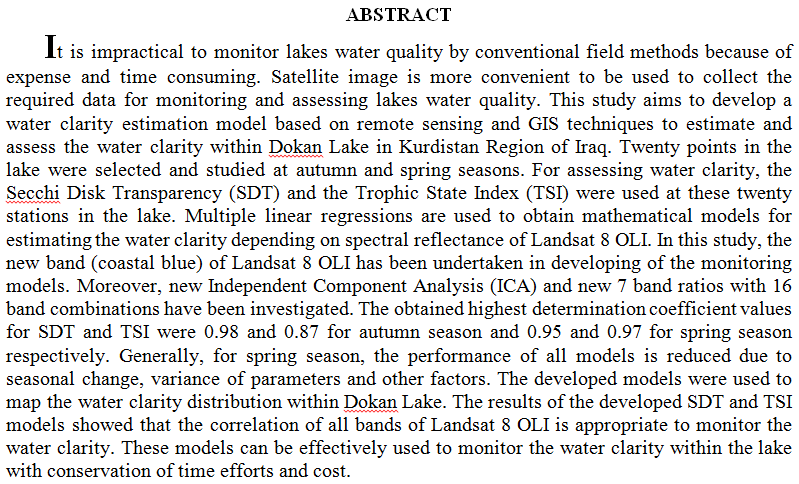
An integrated GIS-VBA (Geographical Information System – Visual Basic for Application), model is developed for selecting an optimum water harvesting dam location among an available locations in a watershed. The proposed model allows quick and precise estimation of an adopted weighted objective function for each selected location. In addition to that for each location, a different dam height is used as a nominee for optimum selection. The VBA model includes an optimization model with a weighted objective function that includes beneficiary items (positive) , such as the available storage , the dam height allowed by the site as an indicator for the potential of hydroelectric power generation , the rainfall rate as a source of water . In a
... Show MoreOne of the main environmental problems which affect extensively the areas in the world is soil salinity. Traditional data collection methods are neither enough for considering this important environmental problem nor accurate for soil studies. Remote sensing data could overcome most of these problems. Although satellite images are commonly used for these studies, however there are still needs to find the best calibration between the data and real situations in each specified area. Landsat satellite (TM & ETM+) images have been analyzed to study soil pollution (Exacerbation of salinity in the soil without the use of abandoned agricultural for a long time) at west of Baghdad city of Iraqi country for the years 1990, 2001 & 2007. All of the th
... Show MoreClarity and Visual Ratios of the Vibrant Place Making
The study investigates the water quality of the Orontes River, which is considered one of the important water recourses in Syria, as it is used for drinking, irrigation, swimming and industrial needs. A database of 660 measurements for 13 parameters concentrations used, were taken from 11 monitoring points distributed along the Orontes River for a period of five years from 2015-2019, and to study the correlation between parameters and their impact on water quality, statistical analysis was applied using (SPSS) program. Cluster analysis was applied in order to classify the pollution areas along the river, and two groups were given: (low pollution - high pollution), where the areas were classified according to the sources of pollution to w
... Show More (9)
(9)
 (4)
(4)
The quality of groundwater in the Al-Hawija area was assessed using a water quality index. Data of nine physico-chemical parameters of 28 groundwater wells were used to calculate the water quality index (WQI). A heterogeneous water quality was reported, where in close proximity to the Lesser Zab River (LZR), it has low WQI values and permissible for human consumptions due to the dilution processes by fresh water; whereas, it becomes deteriorated in areas located far away the river. The values of WQI ranges from 22 to 336, indicating a good to very poor groundwater quality.
 (2)
(2)
In this study water quality was indicated in terms of Water Quality Index that was determined through summarizing multiple parameters of water test results. This index offers a useful representation of the overall quality of water for public or any intended
use as well as indicating pollution, which are useful in water quality management and decision making. The application of Water Quality Index (WQI) with ten physicochemical water quality parameters was performed to evaluate the quality of Euphrates River water for drinking usage. This was done by subjecting the water samples collected from seven stations within Al-Anbar province during the period 2004-2010 to comprehensive physicochemical analysis. The ten physicochemical paramete
 (4)
(4)
In this study water quality was indicated in terms of Water Quality Index that was determined through summarizing multiple parameters of water test results. This index offers a useful representation of the overall quality of water for public or any intended use as well as indicating pollution, which are useful in water quality management and decision making. The application of Water Quality Index (WQI) with ten physicochemical water quality parameters was performed to evaluate the quality of Euphrates River water for drinking usage. This was done by subjecting the water samples collected from seven stations within Al-Anbar province during the period 2004-2010 to comprehensive physicochemical analysis. The ten physicochemical parame
... Show MoreIn cognitive radio system, the spectrum sensing has a major challenge in needing a sensing method, which has a high detection capability with reduced complexity. In this paper, a low-cost hybrid spectrum sensing method with an optimized detection performance based on energy and cyclostationary detectors is proposed. The method is designed such that at high signal-to-noise ratio SNR values, energy detector is used alone to perform the detection. At low SNR values, cyclostationary detector with reduced complexity may be employed to support the accurate detection. The complexity reduction is done in two ways: through reducing the number of sensing samples used in the autocorrelation process in the time domain and through using the Slid
... Show More (7)
(7)
 (4)
(4)
 (7)
(7)
 (5)
(5)
Water is an essential aspect of life and important in evolution. Recently the potable water quality topic has received much attention. The study aims to determine drinking water quality in Al-Najaf City by collecting samples throughout Al-Najaf city and comparing the results with the Iraqi guidelines (IQS 417) and World Health Organization (WHO) guidelines, as well as to calculate the WQI. Samples were tested in the laboratory between December 2021 and June 2022. The results showed that multiple parameters exceeded the allowable limits during both testing periods; during winter months, the results of TDS and turbidity exceeded the upper limits in multiple locations. Total hardness values also
... Show More